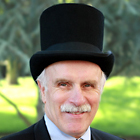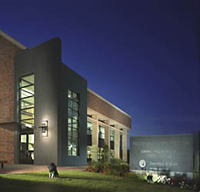Back to Digital Preservation Pioneers
 Washington State Archivist Jerry Handfield traces his work on the innovative Washington State Digital Archives back to a history project he did in high school in Norwich, Connecticut.
Washington State Archivist Jerry Handfield traces his work on the innovative Washington State Digital Archives back to a history project he did in high school in Norwich, Connecticut.
Handfield had to virtually "move" an 1830s-era family from the East cross country to the Oregon territories, drawing upon historical people and events. As his research took him through memoirs, biographies, newspapers and public records, he became more absorbed in the work than expected. He relished solving mysteries, and discovered a dedication to and a knack for historical research. He felt the vitality of history and sensed that the lines connecting the past and present are taut and humming with relevance. His career course was set.
After graduate school, Handfield moved to Indiana and taught history at Indiana University and Purdue University at Indianapolis. He moved on to work at the Indiana State Library from 1976 to 1982. During that time he conducted several hundred oral history interviews. He said, "It was exciting. You feel that you can't interview enough people, that a way of life is disappearing. You feel like you're running against the clock."
Handfield recalls that the Indiana Extension Homemakers (external link) came to him with a project to interview leaders of the home-extension movement. He suggested that, instead of interviewing the dozen or so leaders, they widen their scope and interview five women from each of Indiana's 92 counties. The outcome would be a greater cross section of women, a truer documentation of women's changing role in the 20th century.
The Indiana Extension Homemakers Association Oral History Project (external link) generated more results than anyone could have hoped for. Public interest was so great that a series of popular books, "Memories of Hoosier Homemakers," were published. The project's success also confirmed for Handfield that he could have more impact by training people to conduct oral-history interviews than by trying to conduct interviews alone.
From 1987 until 2001, Handfield served as the Indiana State Archivist and headed the Commission on Public Records as a gubernatorial appointee. During this time he became a fervent advocate for electronic records. He attributes his belief in the value of digital materials to three events.

Washington State Digital Archives
The first was in the late 1980s when a library conference speaker wielding a state-of-the-art NeXT computer took audience requests to query a database of book titles residing on his computer. It was a revelation to Handfield how much information could fit on a small computer. "It startled me," he said.
The second event demonstrated the capability of a few people utilizing the right technology. Handfield's office had to design print-ready forms and, thinking in traditional pencil-and-T-square terms, his staff managers estimated a need to equip ten of his staff with computers to do the job. After an expert computer user analyzed the situation, Handfield found that two staff with computers could do the same amount of work.
The third episode took place in the early 1990s when Handfield learned about the value of electronic records for government archives. After he got some advanced electronic records training at the University of Pittsburgh, he realized the urgency for archives to meet the digital age head on. Since an archive has millions of public government records, what could be better for the citizens than posting 19th century records on a website? He appointed Indiana’s first electronic records archivist in 1993.
During a conference and a vacation to the Pacific Northwest in 2001, Handfield consulted with Washington State officials regarding their unexpected vacant state-archivist position. This encounter led to the Washington Secretary of State Sam Reed offering Handfield the job with a specific request to help him build the nation's first state government electronic records archives. Handfield accepted.
Handfield led the Washington State Archives staff -- most of whom were traditional paper-trained archivists -- to adopt a new technology and a new way of dealing with a digital archives. "This was not just another format change," Handfield said. "This was a revolution." He led the institution in its pioneering launch of the Washington State Digital Archives in 2004.
As part of their research and preparation, Handfield and other Washington state officials visited the Library of Congress, the National Archives and Records Administration and Microsoft to help understand the latest developments in digital preservation and information technology.
Handfield employed a small, flexible team of archivists and engineers. They kept their technology development in-house, relying for the most part on Microsoft software. The team built a system based on an open architecture, which allows for replacing specific software components with different proprietary or open-source products.
In 2007, the Library of Congress provided funding for the Washington State Digital Archives to lead the Multi-State Preservation Consortium. This project currently involves eight other states using the Washington State Digital Archive to provide preservation and access services for valuable government information in digital form. Several other states are expected to join the project in the near future.
When the project ends, the partner states will have the option of developing their own preservation solution or of using the Washington system on a fee-for-service basis. In either case, Handfield believes that the practice of geographic distribution of data should continue. "The protection and security of the data would be improved by storing records at multiple sites," he said.
Handfield is also interested in cloud computing as a strategy for geographically disbursing data for safekeeping. He still seems to be pondering the virtual movement of people and records after all these years when he declares "the cloud is where we're headed."
